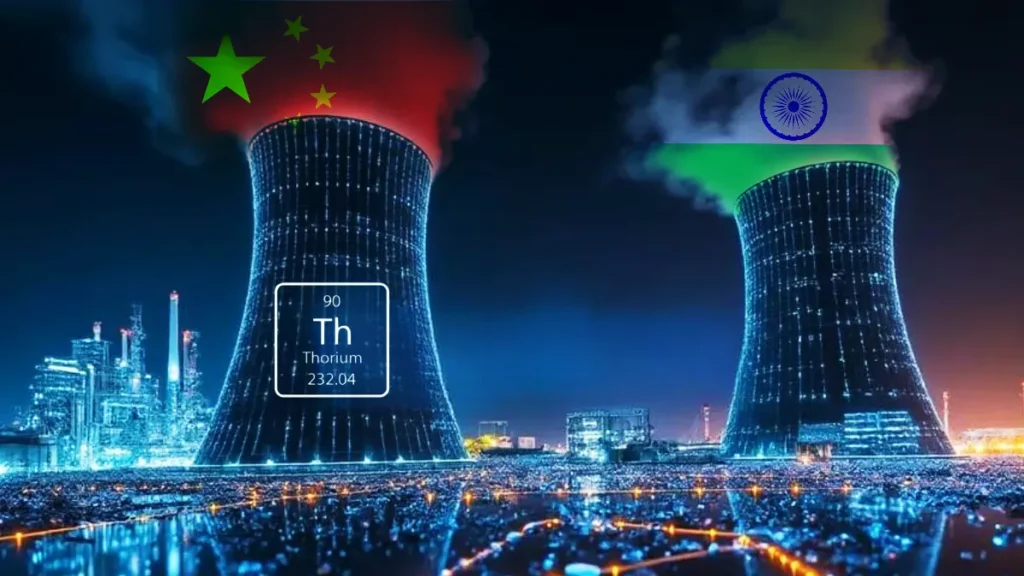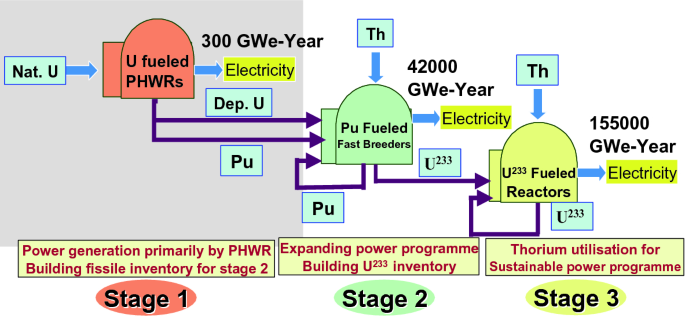
India has some of the largest thorium reserves in the world, making it a global leader in thorium resources. The latest estimates place India’s thorium reserves between 457,000 and 1,070,000 tonnes, with the most widely cited figure being around 846,000 tonnes of thorium metal.
Key Details About Thorium Reserves in India
-
- Main Reservoirs: The majority of India’s thorium is found in the form of monazite sands along the coasts of Kerala, Odisha, Tamil Nadu and also in West Bengal and Andhra Pradesh. Kerala and Odisha together account for over 70% of India’s thorium reserves.
-
- Monazite Resources: India has over 11.93 million tonnes of in-situ monazite, which contains about 1.07 million tonnes of thorium.
-
- Distribution: Major states with thorium-bearing monazite include:
-
- Odisha: 2.41 million tonnes of monazite
-
- Andhra Pradesh: 3.72 million tonnes
-
- Tamil Nadu: 2.46 million tonnes
-
- Kerala: 1.90 million tonnes
-
- West Bengal: 1.22 million tonnes
-
- Jharkhand: 0.22 million tonnes
-
- Distribution: Major states with thorium-bearing monazite include:
Importance for India
-
- Strategic Resource: India leverages these vast thorium reserves as part of its long-term nuclear energy plans, particularly the three-stage nuclear power program, which aims to move towards thorium-based reactors for sustainable energy security.
-
- Global Share: Reports estimate India possesses about 12–30% of world’s thorium reserves, making it vital for future nuclear energy production.
Summary Table
| State | Monazite (Million Tonnes) | Thorium Share (%) |
|---|---|---|
| Odisha | 2.41 | 20 |
| Andhra Pradesh | 3.72 | 31 |
| Tamil Nadu | 2.46 | 21 |
| Kerala | 1.90 | 16 |
| West Bengal | 1.22 | 10 |
| Jharkhand | 0.22 | 2 |
| Total | 11.93 | 100 |
India’s thorium reserves position the country to potentially unlock a future of indigenous, low-carbon nuclear power, reducing reliance on imported uranium and promoting energy sustainability for centuries.
Why is thorium considered more sustainable for India’s energy needs
Thorium is considered more sustainable for India’s energy needs for several key reasons:
-
- Abundance and Domestic Availability: India has the largest thorium reserves in the world, mainly in coastal states like Kerala, Odisha, Tamil Nadu, and Andhra Pradesh. This abundance reduces dependency on imported uranium, enhancing India’s energy security and self-reliance.
-
- Cleaner and Lower Waste: Thorium-based reactors produce significantly less long-lived radioactive waste compared to conventional uranium-based reactors. This makes it a cleaner option with less environmental and disposal challenges.
-
- Higher Fuel Efficiency: Thorium can generate more fissile material (uranium-233) than it consumes, allowing more efficient fuel utilization and potentially longer-lasting fuel cycles.
-
- Reduced Proliferation Risk: Thorium fuel cycles produce negligible plutonium, which limits the risk of nuclear weapon proliferation due to the presence of hard gamma radiation in the spent fuel that deters weaponization.
-
- Lower Greenhouse Gas Emissions: Nuclear power in general, including thorium-based energy, produces negligible greenhouse gas emissions during operation, supporting India’s climate goals for a sustainable and carbon-free energy future.
-
- Long-Term Energy Solution: Given its abundance and the ability to breed fissile material from thorium, it offers a practically inexhaustible energy source for India’s long-term energy strategy under the three-stage nuclear program.
Thus, thorium aligns with India’s goals of energy security, reduced environmental impact, and long-term sustainable energy generation, making it a pivotal element in India’s nuclear energy plans.
The Advanced Heavy Water Reactor (AHWR) being developed by India demonstrates thorium’s viability, aiming for a safer, more efficient, and sustainable nuclear fuel cycle option.
In summary, thorium’s abundance, cleaner waste profile, enhanced fuel efficiency, proliferation resistance, and low carbon footprint make it a more sustainable choice for India’s energy future.

How does India’s three-stage nuclear plan optimize thorium use for sustainability:
India’s three-stage nuclear plan optimizes thorium use for sustainability through a carefully phased approach designed to overcome the limitations of uranium availability and to fully exploit India’s vast thorium reserves:
Stage I: Pressurized Heavy Water Reactors (PHWRs)
-
Use natural uranium as fuel.
-
Generate electricity while producing plutonium-239 as a byproduct.
-
The plutonium produced here is critical for the second stage.
-
Enable self-reliance by beginning nuclear power generation using available uranium resources.
Stage II: Fast Breeder Reactors (FBRs)
-
Use plutonium-239 from Stage I as fuel.
-
Breed more fissile material by converting uranium-238 into plutonium.
-
Simultaneously, thorium-232 is used in blankets around the core to breed uranium-233, a fissile material needed for thorium fuel cycles.
-
Increase fissile material stockpiles required for the third stage.
-
Achieve a “breeding” gain, producing more fissile material than consumed, which sustains the fuel cycle.
Stage III: Thorium-Based Advanced Nuclear Reactors
-
Utilize uranium-233 bred from thorium-232 in Stage II alongside thorium itself as fuel.
-
Employ thermal breeder reactors such as the Advanced Heavy Water Reactor (AHWR) designed to run on thorium-uranium-233 mixed fuel.
-
Aim for a self-sustaining thorium fuel cycle that can provide long-term, near-renewable nuclear energy.
-
Reduce nuclear waste and proliferation risks due to thorium’s properties.
-
Maximize energy extracted from thorium, India’s abundant resource, making nuclear power more sustainable and secure.
Overall Optimization for Sustainability:
-
Judicious use of limited uranium: The program starts by using scarce uranium efficiently to generate plutonium.
-
Breeding fissile materials: Fast breeder reactors create more fissile fuel than they consume, vital for scaling up thorium use.
-
Harnessing thorium’s potential: The third stage promises to leverage India’s large thorium reserves for extensive nuclear power production.
-
Closed fuel cycle: Reprocessing spent fuel to recover and recycle fissile materials minimizes waste and optimizes resource use.
-
Long-term energy security: The program is designed to provide India with a near-perpetual supply of nuclear fuel using domestic resources.
-
Environmental benefits: Thorium reactors produce less long-lived radioactive waste and have lower proliferation risks, supporting sustainable development goals.
In summary, India’s three-stage nuclear plan strategically transitions from uranium-based reactors to advanced thorium reactors, optimizing thorium use by breeding necessary fissile material and enabling a closed fuel cycle. This maximizes energy output, minimizes waste, and makes nuclear power a sustainable and secure energy source for India’s long-term needs..